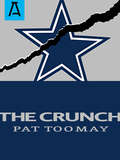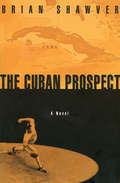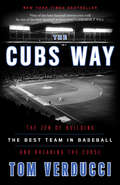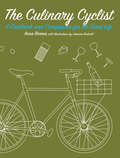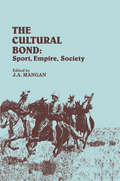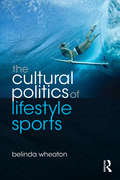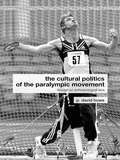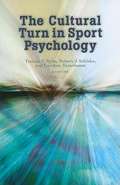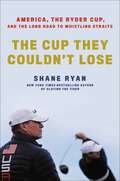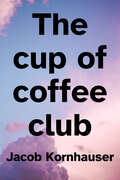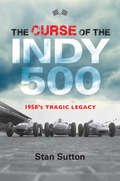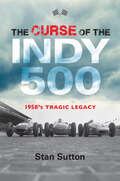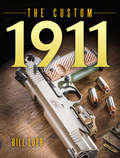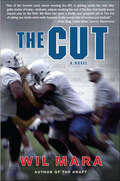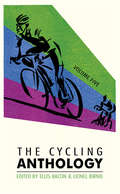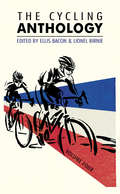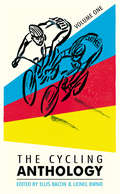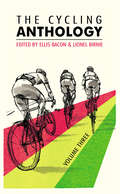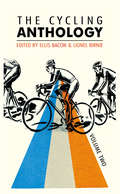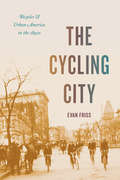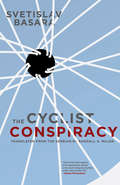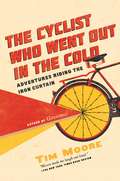- Table View
- List View
The Crunch
by Pat Toomay"A wry, witty look at life with the Dallas Cowboys during the heyday of Tom Landry and Roger Staubach, The Crunch shows the real life that makes legends and lacerates the Cowboys mechanistic corporate image, revealing a world that is both more and less than we expect, yet funnier than we could image." --Peter Gent, author of North Dallas Forty "More characters than War and Peace. More laughs than Laugh-In. . . . A pro football classic!" --Frank Luksa, The Dallas Morning News
The Cuban Prospect: A Novel
by Brian ShawverFrom the author of Aftermath: “A nervy debut . . . A Heart of Darkness set deep in the bowels of the major-league farm system” (Chicago Tribune). With compassionate intensity and great heart, Brian Shawver, in his powerful debut novel, tells the story of Dennis Birch, a thirty-four-year old failed major league ball player turned minor league scout whose field of dreams has always been baseball. No longer a candidate for baseball greatness himself—if he ever was—Dennis accepts the challenge of smuggling a hot right-handed pitcher out of Cuba in the hope that promoting the greatness of another will somehow confer a small, manageable portion of it on himself. Birch’s innocent belief in the rightness of his mission blinds him to some of the realities of it, and what seems at first to be a straight road to glory and his name on a plaque in Cooperstown, leads him into dangerous, sordid, and morally complex waters. As becomes excruciatingly clear, Fidel Castro’s Cuba is much further from the Florida Keys than the miles marked on a map. “Deeply felt and compelling . . . informed with a moral passion not so often found today. The game of baseball is convincingly used as the background for games of a more terrible kind.” —Barry Unsworth “First-novelist Shawver writes with sad passion about small lives swirling aimlessly in search of external verification when perhaps an inward glance is all that’s needed.” —Booklist “This likable first effort is sure to find fans among readers of baseball novels, if not a wider audience.” —Publishers Weekly
The Cubs Way: The Zen of Building the Best Team in Baseball and Breaking the Curse
by Tom Verducci<P>With inside access and reporting, Sports Illustrated senior baseball writer and FOX Sports analyst Tom Verducci reveals how Theo Epstein and Joe Maddon built, led, and inspired the Chicago Cubs team that broke the longest championship drought in sports, chronicling their epic journey to become World Series champions. It took 108 years, but it really happened. The Chicago Cubs are once again World Series champions. <P>How did a team composed of unknown, young players and supposedly washed-up veterans come together to break the Curse of the Billy Goat? Tom Verducci, twice named National Sportswriter of the Year and co-writer of The Yankee Years with Joe Torre, will have full access to team president Theo Epstein, manager Joe Maddon, and the players to tell the story of the Cubs' transformation from perennial underachievers to the best team in baseball. <P>Beginning with Epstein's first year with the team in 2011, Verducci will show how Epstein went beyond "Moneyball" thinking to turn around the franchise. Leading the organization with a manual called "The Cubs Way," he focused on the mental side of the game as much as the physical, emphasizing chemistry as well as statistics. To accomplish his goal, Epstein needed manager Joe Maddon, an eccentric innovator, as his counterweight on the Cubs' bench. A man who encourages themed road trips and late-arrival game days to loosen up his team, Maddon mixed New Age thinking with Old School leadership to help his players find their edge. <P>The Cubs Way takes readers behind the scenes, chronicling how key players like Rizzo, Russell, Lester, and Arrieta were deftly brought into the organization by Epstein and coached by Maddon to outperform expectations. Together, Epstein and Maddon proved that clubhouse culture is as important as on-base-percentage, and that intangible components like personality, vibe, and positive energy are necessary for a team to perform to their fullest potential. Verducci chronicles the playoff run that culminated in an instant classic Game Seven. He takes a broader look at the history of baseball in Chicago and the almost supernatural element to the team's repeated loses that kept fans suffering, but also served to strengthen their loyalty. <P>The Cubs Way is a celebration of an iconic team and its journey to a World Championship that fans and readers will cherish for years to come. <P><b>A New York Times Bestseller</b>
The Culinary Cyclist: A Cookbook And Companion For The Good Life
by Anna Brones Johanna KindvallThe first cookbook of its kind, The Culinary Cyclist is a gorgeous staple for any kitchen where bicycling and healthy, delicious food are priorities. This lovingly illustrated cookbook is your guide to hedonistic two-wheeled living. Recipes are all gluten free and vegetarian. Decadent basics such as a creamy sea salt chocolate cake and baked eggs in avocado halves are paired with cheerful instructions for gracefully hosting a dinner party, gifting food, bulk shopping by bicycle, and two-wheeled picnics. The cookbook is suitable for experienced cooks looking to add kitchen flair to their repertoire as well as beginners in the kitchen who want to start out their culinary lives on the right foot.
The Cultural Bond: Sport, Empire, Society (Sport in the Global Society)
by J. A. ManganThe contributors to this volume examine the aspects of the cultural associations, symbolic interpretations and emotional significance of the idea of empire and, to some extent, with the post-imperial consequences. Collectively and cumulatively, their view is that sport was an important instrument of imperial cultural association and subsequent cultural change, promoting at various times and in various places imperial unity, national identity, social reform, recreational development and post-imperial goodwill.
The Cultural Politics of Lifestyle Sports (Routledge Critical Studies in Sport)
by Belinda WheatonThis important new study examines the changing place and meaning of lifestyle sports – parkour, surfing, skateboarding, kite-surfing and others – and asks whether they continue to pose a challenge to the dominant meanings and experience of ‘sport’ and physical culture. Drawing on a series of in-depth, empirical case-studies, the book offers a re-evaluation of theoretical frameworks with which lifestyle sports have been understood, and focuses on aspects of their cultural politics that have received little attention, particularly the racialization of lifestyle sporting spaces. Centrally, it re-assess the political potential of lifestyle sports, considering if lifestyle sports cultures present alternative identities and spaces that challenge the dominant ideologies of sport, and the broader politics of identity, in the 21st century. It explores a range of key contemporary themes in lifestyle sport, including: identity and the politics of difference commercialization and globalization sportscapes, media discourse and lived reality risk and responsibility governance and regulation the racialization of lifestyle sports spaces lifestyle sports outside of the Global North the use of lifestyle sport to engage non-privileged youth Casting new light on the significance of sport and sporting subcultures within contemporary society, this book is essential reading for students or researcher working in the sociology of sport, leisure studies or cultural studies.
The Cultural Politics of Post-9/11 American Sport: Power, Pedagogy and the Popular (Routledge Research in Sport, Culture and Society)
by Michael SilkMuch of the writing on the post-9/11 period in the United States has focused on the role of "official" Government rhetoric about 9/11. Those who have focused on the news media have suggested that they played a key role in (re)defining the nation, allowing the citizenry to come to terms with 9/11, in providing ‘official’ understandings and interpretations of the event, and setting the terms for a geo-political-military response (the war on terror). However, strikingly absent from post-9/11 writing has been discussion on the role of sport in this moment. This text provides the first, book-length account, of the ways in which the sport media, in conjunction with a number of interested parties – sporting, state, corporate, philanthropic and military – operated with a seeming collective affinity to conjure up nation, to define nation and its citizenry, and, to demonize others. Through analysis of a variety of cultural products – film, children’s baseball, the Super Bowl, the Olympics, reality television – the book reveals how, in the post-9/11 moment, the sporting popular operated as a powerful and highly visible pedagogic weapon in the armory of the Bush Administration, operating to define ways of being American and thus occlude other ways of being.
The Cultural Politics of the Paralympic Movement: Through an Anthropological Lens (Routledge Critical Studies in Sport)
by David HoweDo the Paralympic Games empower the disability sport community? Like many other contemporary sporting institutions, the Paralympic Games have made the transition from pastime to spectacle, and the profile of athletes with disabilities has been increased as a result. This book reviews the current status of the Paralympics and challenges the mainstream assumption that the Games are a vehicle for empowerment of the disabled community. Using ethnographic methods unique in this area of study, P. David Howe has undertaken an innovative and critical examination of the social, political and economic processes shaping the Paralympic Movement. In The Cultural Politics of the Paralympic Movement he presents his findings and offers a new insight into the relationship between sport, the body and the culture of disability. In doing so he has produced the most comprehensive and radical text about high performance sport for the disabled yet published. P. David Howe is Lecturer in the Sociology of Sport at Loughborough University. He is also a four-time Paralympian and former Athlete’s Representative to the International Paralympic Committee.
The Cultural Turn in Sport Psychology
by Gershon Tenenbaum Robert J. Schinke Tatiana V. RybaThe Cultural Turn in Sport Psychology brings to bear a series of rich insights from cultural studies that demand ways of opening the study of sport psychology to issues of transnational, gendered, and sexual identities; new methodologies; the nature of expertise and professional practice; and the basis of the science of sport psychology itself. In a global world with increasingly complex issues around issues of embodiment and the rapidly changing and expanding nature of the sporting enterprise, these broadened perspectives on sport psychology are both enlightening and valuable. -from the Foreword by Patricia Vertinsky, cultural historian, University of British Columbia.
The Cup They Couldn't Lose: America, the Ryder Cup, and the Long Road to Whistling Straits
by Shane RyanThe definitive story of the Ryder Cup—the event that pits the best golfers from America against the best from Europe—exploring the modern history of the tournament that led to the showdown at Whistling Straits in 2021. The task facing Steve Stricker at the 2021 Ryder Cup was enormous. It was his job, as the American captain, to stare down almost 40 years of Ryder Cup history, break a pattern of home losses that had persisted almost as long, and reverse the tide of European dominance in one of golf's most tense and emotional events. This was the epitome of a must-win, but it was also something more—in the entire 93-year history of the event, no American side had ever faced this kind of pressure. Starting on the morning of September 24, those 12 players competed not just for a Cup, or for pride, but to save the reputation of the U.S. team itself. The great mystery of the Ryder Cup is that America loses despite having superior individual talent. The European renaissance began in the 1980s, led by the brilliant Tony Jacklin and Seve Ballesteros, and since then, the U.S. has suffered a slew of embarrassing defeats abroad and at home. The signs in 2021 weren&’t good: Tiger Woods was out after his horrific car crash, Patrick Reed (&“Captain America,&” to his supporters) was hospitalized with double pneumonia weeks before the event, and America had to rely on its rising stars—including Bryson DeChambeau and Brooks Koepka, who spent most of the year immersed in an escalating feud—to prove their mettle. Meanwhile, the European team had a few major stars of its own, like Jon Rahm, the world no. 1 and the first Spanish player ever to win the U.S. Open, and Rory McIlroy, the four-time major winner. Throw in the complications of a global pandemic, and the stage was set for one of the strangest Ryder Cups ever. Following the drama in Wisconsin while deconstructing the rich history of the tournament, The Cup They Couldn't Lose tells the story of how the U.S. defeated Europe in record fashion, restored their status as golf&’s global superpower, and transformed their entire way of thinking in order to truly understand the nature of the Ryder Cup.**The Sports Librarian&’s Best of 2022 – Sports Books**
The Cup of Coffee Club: 11 Players and their Brush With Baseball History
by Jacob KornhauserMost baseball players will never reach the major leagues. While many that do stay there for a long time, there are a select few that played in just one major league game. Cup of Coffee Club tells the stories of eleven of these players and their struggles to reach the major leagues, as well as their struggles to get back.
The Curse of the Bambino
by Dan ShaughnessyIt's all here. If you are into masochism, you can relive again the ground ball through Buchner's legs or the innumerable almost but not quite experiences of the Boston Redsox since that fateful day in 1919 when the owner traded away the greatest baseball player of all time, Babe Ruth. The writing is excellent and the history is fascinating. This is very highly recommended.
The Curse of the Indy 500: 1958's Tragic Legacy
by Stan SuttonOn May 30, 1958, thousands of racing fans poured into the infield at dawn to claim the best seats of the Indianapolis 500, unaware that they were going to witness one of the most notorious wrecks in racing history. Seconds after the green flag, a game of chicken spiraled out of control into a fiery 16-car pile-up that claimed the life of 29-year-old Indiana native and rising star Pat O’Connor. The other drivers escaped death, but the tragic 1958 Indy 500 seemed to leave its mark on them: the surviving drivers were hounded by accidents and terrible crashes, and most would die at tracks around the country. But the tragedy also prompted new regulations and safety precautions like roll bars that would ultimately save hundreds of lives. In The Curse of Indy 500: 1958’s Tragic Legacy, veteran sportswriter Stan Sutton profiles the ill-fated race and the careers of the drivers involved, highlighting their lives in the dangerous world of auto racing.
The Curse of the Indy 500: 1958's Tragic Legacy
by Stan Sutton“[A] rich history built around the 1958 tragedy that claimed one of the Indy 500’s most beloved drivers . . . evokes a unique and unforgettable era.” —Dan Carpenter, freelance writer, former Indianapolis Star columnistOn May 30, 1958, thousands of racing fans poured into the infield at dawn to claim the best seats of the Indianapolis 500, unaware that they were going to witness one of the most notorious wrecks in racing history. Seconds after the green flag, a game of chicken spiraled out of control into a fiery 16-car pile-up that claimed the life of 29-year-old Indiana native and rising star Pat O’Connor. The other drivers escaped death, but the tragic 1958 Indy 500 seemed to leave its mark on them: the surviving drivers were hounded by accidents and terrible crashes, and most would die at tracks around the country. But the tragedy also prompted new regulations and safety precautions like roll bars that would ultimately save hundreds of lives. In The Curse of Indy 500: 1958’s Tragic Legacy, veteran sportswriter Stan Sutton profiles the ill-fated race and the careers of the drivers involved, highlighting their lives in the dangerous world of auto racing.“In all, the book offers an exciting story of the 1958 Indy 500 and a thought-provoking discussion of its aftermath.” —Daily Journal“A meticulous contextual account of events leading into what possibly triggered the starting tension, what follows in the wake of the fiery first-lap death of Pat O’Conner, and what other Indy 500 tragedies have failed to get the notice generated on and following May 30, 1958.” —NUVO
The Custom 1911
by Bill LoebThe 1911 is ambiguous as it is classic. The gun's mission changed over the years. Originally a military sidearm, the 1911 is now a favorite among law enforcement special operation units, military and competitors, as well as those interested in self-defense.While the basic design has changed very little, some brilliant people have advanced John Browning's classic and brought it into a new century.This book offers some amazing behind-the-scenes insight about the makers of Nighthawk, Kimber, Wilson Combat, to name a few. Great shooters like Julie Golob, Bruce Piatt and Chip McCormick shared their personal stories. Ted Nugent and Razor Dobbs also make appearances as 1911 hunters. These 1911 stars also shared their practical advice which Bill shares with the reader.Bill Loeb's writing style is concise yet sometimes irreverent, but always fresh and entertaining.
The Cut: A Novel
by Wil MaraAfter only his second year with the New York Giants, T. J. Brookman has become the best tight end in professional football. His stats are nothing short of amazing---and what's even more amazing is that he was only a sixth-round pick in the first place. With one season remaining on his rookie contract, his agent, Barry Sturtz, wants to renegotiate and get a more lucrative deal---a common practice among players who have exceeded expectations. But the Giants refuse. They want Brookman to play through his last year, then they'll talk about a new contract. Sturtz, however, doesn't trust them. He wants the deal now—and if he doesn't get it, he's going to instruct T.J. to boycott the team's upcoming training camp. Head coach Alan Gray doesn't flinch at the threat—if T.J. doesn't show, he says, they'll simply bench him. Sturtz thinks it's a bluff---the Giants have had problems with offensive production, and T.J. is their only bright spot. But Gray insists he's serious. No one is more stunned by this development than offensive coordinator Dale Greenwood. Having struggled in polite subordination under Gray's megalomaniacal leadership, the talented Greenwood is concerned that he will now lose his most productive receiver. He suspects Gray's true motivation is that he simply doesn't want to spend the money on a tight end---Gray is a defensive-minded coach with little interest in the offensive side of the ball. What Gray really wants is for everything to stay just the way it is. And to create the necessary leverage, he orders Greenwood to bring in three "camp bodies"---decoys, essentially---to compete for T.J.'s job. Greenwood has no choice but to comply, and he assembles a trio of unsigned players from the bottomless pool of league wannabes. What no one anticipates, however, is that these three recruits have more drive and talent than anyone expected. Delighted, Gray believes Sturtz will soon be at his mercy. But neither Sturtz nor any the three hopefuls are willing to be a part of Alan Gray's plan. Many variables are in play here, both on and off the field. And as any student of the game knows, there are more losers than winners on the last day of preseason---a day known as the Cut.
The Cycling Anthology: Volume Five (5/5) (The Cycling Anthology #5)
by Jeremy Whittle Daniel Friebe Andy McGrathProfessional cycling is a rich, dynamic and often controversial sport that lends itself to great writing. Some of the most famous and illustrious races were founded by newspapermen and The Cycling Anthology continues this tradition by bringing together the best in the business. Volume Five is an eclectic mix of stories old and new:As World War One is commemorated acros the globe, Brendan Gallagher looks at cycling's war heroes and the role the bicycle played in WWI. Jeremy Whittle goes in search of panache - why you don't always have to be a winner to be a winner in the public's eyes.Francois Thomazeau examines how the Tour de France became the international event it is today. The 2014 Tour de France is relived in the form of poetry, by Ellis Bacon. Lionel Birnie tells the story behind the Linda McCartney cycling team, the great British team that could have been. Joey McLoughlin was a shining star of the British cycling scene in the 1980s and '90s - Andy McGrath finds out what happened to him. Edward Pickering returns to one of cycling's great Pyrenean climbs - Superbagneres. As Matt Beaudin finds out, the Tour de France is a treat for the senses - albeit a loud one. Matt McGeehan sends a postcard from the 2014 World Track Championships in Colombia. And Daniel Friebe introduces us to Jean Francois Naquet-Radiguet: Tour de France pioneer.
The Cycling Anthology: Volume Four (4/5) (The Cycling Anthology #4)
by William Fotheringham Richard Moore Daniel Friebe Ellis BaconProfessional cycling is a rich, dynamic and often controversial sport that lends itself to great writing. Some of the most famous and illustrious races were founded by newspapermen and The Cycling Anthology continues this tradition by bringing together the best in the business. Volume Four features original and exclusive pieces by leading cycling writers. William Fotheringham remembers the journalist who was instrumental in bringing road-racing to a British audience; Ellis Bacon looks beyond Queen to the link between bikes and beats; Richard Moore finds out what happened to that ‘little punk’ (Lance Armstrong’s words), Iban Mayo, and asks if he really did become a long-distance lorry driver; Daniel Friebe re-examines the ups and downs of Marco Pantani; Tom Southam explains what it’s like not to ride the Tour de France; and much more.Between them, these writers have covered hundreds of Tours de France and written dozens of excellent books and some have even ridden the Tour. Here, their work is showcased together.
The Cycling Anthology: Volume One (1/5) (The Cycling Anthology #1)
by VariousTHE ULTIMATE GUIDE TO CYCLING IN FIVE VOLUMESVolume One of The Cycling Anthology, a collection of the best writing on cycling by some of the sport's leading writers. Between them, they’ve covered hundreds of Tours de France and written dozens of excellent books and some have even ridden the Tour. Now, their work is showcased together for the first time.Volume One features original and exclusive pieces by leading cycling writers, including:- William Fotheringham disects Bradley Wiggins' transformation from track superstar to becoming the first Briton to win the Tour de France- David Millar discusses retirement and dark secrets as his friends' careers start to fade- Daniel Friebe uncovers the fascinating role statistics has to play in cycling- Jeremy Whittle follows Team Sky to assess the Lance Armstrong's legacy to the sport
The Cycling Anthology: Volume Three (3/5) (The Cycling Anthology #3)
by Richard Moore Jeremy Whittle Ned BoultingProfessional cycling is a rich, dynamic and often controversial sport that lends itself to great writing. Some of the most famous and illustrious races were founded by newspapermen and The Cycling Anthology continues this tradition by bringing together the best in the business. Volume Three features original and exclusive pieces by leading cycling writers. Ned Boulting goes behind the scenes at the 2013 Tour de France to get to know the second British winner in two years, Chris Froome; Richard Moore tells the story of Marianne Martin, winner of the first women's Tour de France; Lionel Birnie recounts the story of the Tour of Britian through the prism of the 2013 edition; Jeremy Whittle assess how the aftermath of Lance Armstrong's sensational confession affected Team Sky; and many more. Between them, they’ve covered hundreds of Tours de France and written dozens of excellent books and some have even ridden the Tour. Here, their work is showcased together.
The Cycling Anthology: Volume Two (2/5) (The Cycling Anthology #2)
by William Fotheringham Jeremy Whittle Ned Boulting Daniel FriebeProfessional cycling is a rich, dynamic and often controversial sport that lends itself to great writing. Some of the most famous and illustrious races were founded by newspapermen and The Cycling Anthology continues this tradition by bringing together the best in the business. Volume Two is a Tour de France special edition and features original and exclusive pieces by leading cycling writers. ITV reporter Ned Boulting looks at how the Tour made it to our living rooms and into our hearts; pro rider Daniel Lloyd lifts the lid on actually riding a Tour in 'A Domestique's Tale'; Jeremy Whittle examines why, despite drug scandal and infamy, the Tour still intoxicates us; and many more. Between them, they’ve covered hundreds of Tours de France and written dozens of excellent books and some have even ridden the Tour. Here, their work is showcased together.
The Cycling City: Bicycles and Urban America in the 1890s
by Evan FrissCycling has experienced a renaissance in the United States, as cities around the country promote the bicycle as an alternative means of transportation. In the process, debates about the nature of bicycles--where they belong, how they should be ridden, how cities should or should not accommodate them--have played out in the media, on city streets, and in city halls. Very few people recognize, however, that these questions are more than a century old. The Cycling City is a sharp history of the bicycle's rise and fall in the late nineteenth century. In the 1890s, American cities were home to more cyclists, more cycling infrastructure, more bicycle friendly legislation, and a richer cycling culture than anywhere else in the world. Evan Friss unearths the hidden history of the cycling city, demonstrating that diverse groups of cyclists managed to remap cities with new roads, paths, and laws, challenge social conventions, and even dream up a new urban ideal inspired by the bicycle. When cities were chaotic and filthy, bicycle advocates imagined an improved landscape in which pollution was negligible, transportation was silent and rapid, leisure spaces were democratic, and the divisions between city and country were blurred. Friss argues that when the utopian vision of a cycling city faded by the turn of the century, its death paved the way for today's car-centric cities--and ended the prospect of a true American cycling city ever being built.
The Cyclist Conspiracy
by Randall A. Major Svetislav BasaraTold through a series of "historical documents"--memoirs, illustrations, letters, philosophical treatises, blue prints, maps--the novel details the tale of a secret Brotherhood who meet in dreams, gain esoteric knowledge from contemplation of the bicycle, and seek to move in and out of history, manipulating events.
The Cyclist Who Went Out in the Cold: Adventures Riding the Iron Curtain
by Tim MooreTim Moore and a rickety metal steed are back together—riding the entirety of the Iron Curtain, where history, mechanical failures, physical endurance, and humor come together for "the Bill Bryson on two wheels." Not content with tackling the Italian Alps or the route of the Tour de France, Tim Moore sets out to scale a new peak of rash over-ambition: 6,000 mile route of the old Iron Curtain on a tiny-wheeled, two-geared East German shopping bike. Asking for trouble and getting it, Moore sets off from the northernmost Norwegian-Russian border at the Arctic winter’s brutal height, bullying his plucky MIFA 900 through the endless sub-zero desolation of snowbound Finland. Sleeping in bank vaults, imperial palaces and unreconstructed Soviet youth hostels, battling vodka-breathed Russian hostility, Romanian landslides and a diet of dumplings, Moore and his ‘so-small bicycle’ are sustained by the kindness of reindeer farmers and Serbian rock gods, plus a shameful addiction to Magic Man energy drink. Haunted throughout by the border detritus of watchtowers and rusted razor wire, Moore reflects on the curdling of the Communist dream, and the memories of a Cold War generation reared on the fear of apocalypse—at a time of renewed East-West tension. After three months, twenty countries and a fifty-eight degree jaunt up the thermostat, man and bike finally wobble up to a Black Sea beach in Bulgaria, older and wiser, but mainly older.
The Cyclist and His Shadow: A Memoir (Univocal)
by Olivier HaralambonA philosopher and former racing cyclist examines how competitive riders lose their sense of self as they pursue perfect motion and mastery over pain After ten years as a racing cyclist, riding in up to ninety races a year, Olivier Haralambon became a journalist and philosopher. In The Cyclist and His Shadow, he writes about the world of competitive cycling with rare honesty and self-reflection, exploring it not merely as a sport but as a spiritual and artistic practice, imbued with a mystical quality. In prose at once poetic and precise, Haralambon depicts the intensity of cycling as physical activity in which the rider&’s consciousness becomes inseparable from the instantaneous movements of limbs, the exertion of heart and lungs, and the marshaling and expenditure of energy. He describes riding as an ascetic activity always accompanied by pain that the cyclist can control but never fully eliminate. But cycling for Haralambon is not only suffering but also an addictively pleasurable activity in which the rider&’s sense of self dissolves and melds with the bicycle, mind and body exploring the vibrant solitude of the course and limits of human endurance. Engaging in the repetition of ascension and the endless hours immersed in an oceanic interior, cyclists are artists in the vastness of landscape, both interior and exterior.Published in association with The Cycling Podcast (https://thecyclingpodcast.com), The Cyclist and His Shadow offers an illuminating meditation on what drives cyclists to devote their lives and bodies to training, racing, and even doping. Drawing from personal experience, Haralambon presents cycling as simultaneously physical and creative, technological and mystical, torturous and ecstatic.
